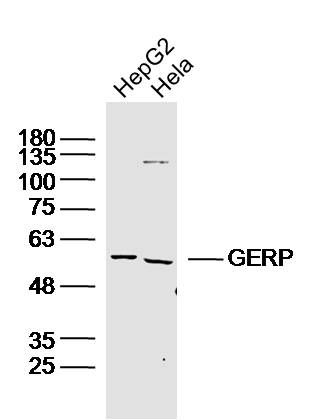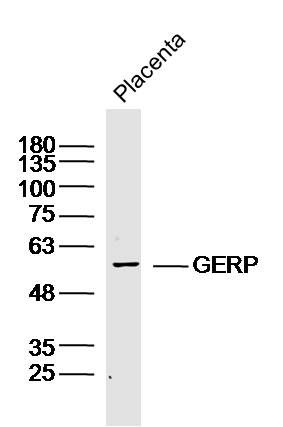GERP Polyclonal Antibody
Purified Rabbit Polyclonal Antibody (Pab)
- SPECIFICATION
- CITATIONS
- PROTOCOLS
- BACKGROUND

Application
| WB, IHC-P, IHC-F, IF, E |
|---|---|
| Primary Accession | Q9BZR9 |
| Reactivity | Rat, Dog |
| Host | Rabbit |
| Clonality | Polyclonal |
| Calculated MW | 61 KDa |
| Physical State | Liquid |
| Immunogen | KLH conjugated synthetic peptide derived from human GERP/TRIM8/RNF27 |
| Epitope Specificity | 61-160/551 |
| Isotype | IgG |
| Purity | affinity purified by Protein A |
| Buffer | 0.01M TBS (pH7.4) with 1% BSA, 0.02% Proclin300 and 50% Glycerol. |
| SIMILARITY | Belongs to the TRIM/RBCC family. Contains 2 B box-type zinc fingers. Contains 1 RING-type zinc finger. |
| SUBUNIT | Homodimer. Interacts with SOCS1 (via) SH2 domain and SOCS box. |
| Important Note | This product as supplied is intended for research use only, not for use in human, therapeutic or diagnostic applications. |
| Background Descriptions | The tripartite motif (TRIM) family of proteins are characterized by a conserved TRIM domain that includes a coiled-coil region, a B-box type zinc finger, one RING finger and three zinc-binding domains. TRIM8 (tripartite motif containing 8), also known as GERP (glioblastoma-expressed RING finger protein) or RNF27 (RING finger protein 27), is a 551 amino acid protein that is thought to function as an E3 ubiquitin-protein ligase that promotes SOCS-1 proteasomal degradation. As a widely expressed homodimer, TRIM8 localizes to nuclear bodies and contains two B box-type zinc fingers and one RING-type zinc finger. TRIM8 is expressed in lung, heart, brain and skeletal muscle, with low levels detected in intestine, placenta, leukocytes and liver. The gene encoding TRIM8 maps to human chromosome 10q24.32. |
| Gene ID | 81603 |
|---|---|
| Other Names | E3 ubiquitin-protein ligase TRIM8, 2.3.2.27, Glioblastoma-expressed RING finger protein, RING finger protein 27, RING-type E3 ubiquitin transferase TRIM8, Tripartite motif-containing protein 8, TRIM8, GERP, RNF27 |
| Target/Specificity | Widely expressed. |
| Dilution | WB=1:500-2000,IHC-P=1:100-500,IHC-F=1:100-500,IF=1:50-200,ELISA=1:5000-10000 |
| Format | 0.01M TBS(pH7.4), 0.09% (W/V) sodium azide and 50% Glyce |
| Storage | Store at -20 ℃ for one year. Avoid repeated freeze/thaw cycles. When reconstituted in sterile pH 7.4 0.01M PBS or diluent of antibody the antibody is stable for at least two weeks at 2-4 ℃. |
| Name | TRIM8 |
|---|---|
| Synonyms | GERP, RNF27 |
| Function | E3 ubiquitin-protein ligase that participates in multiple biological processes including cell survival, differentiation, apoptosis, and in particular, the innate immune response (PubMed:27981609, PubMed:28747347). Participates in the activation of interferon-gamma signaling by promoting proteasomal degradation of the repressor SOCS1 (PubMed:12163497). Plays a positive role in the TNFalpha and IL-1beta signaling pathways. Mechanistically, induces the 'Lys-63'-linked polyubiquitination of MAP3K7/TAK1 component leading to the activation of NF-kappa-B (PubMed:22084099, PubMed:23152791, PubMed:27981609, PubMed:34871740). Also modulates STAT3 activity through negative regulation of PIAS3, either by degradation of PIAS3 through the ubiquitin-proteasome pathway or exclusion of PIAS3 from the nucleus (PubMed:20516148). Negatively regulates TLR3/4-mediated innate immune response by catalyzing 'Lys-6'- and 'Lys-33'-linked polyubiquitination of TICAM1 and thereby disrupting the TICAM1-TBK1 interaction (PubMed:28747347). |
| Cellular Location | Cytoplasm. Nucleus. Nucleus, nuclear body. Note=Nucleo-cytoplasmic translocation is involved in regulation of NF-kappa-B. |
| Tissue Location | Widely expressed. Expressed in glomerular podocytes of kidneys. {ECO:0000269|PubMed:33508234, ECO:0000305} |

Thousands of laboratories across the world have published research that depended on the performance of antibodies from Abcepta to advance their research. Check out links to articles that cite our products in major peer-reviewed journals, organized by research category.
info@abcepta.com, and receive a free "I Love Antibodies" mug.
Provided below are standard protocols that you may find useful for product applications.
If you have used an Abcepta product and would like to share how it has performed, please click on the "Submit Review" button and provide the requested information. Our staff will examine and post your review and contact you if needed.
If you have any additional inquiries please email technical services at tech@abcepta.com.













 Foundational characteristics of cancer include proliferation, angiogenesis, migration, evasion of apoptosis, and cellular immortality. Find key markers for these cellular processes and antibodies to detect them.
Foundational characteristics of cancer include proliferation, angiogenesis, migration, evasion of apoptosis, and cellular immortality. Find key markers for these cellular processes and antibodies to detect them. The SUMOplot™ Analysis Program predicts and scores sumoylation sites in your protein. SUMOylation is a post-translational modification involved in various cellular processes, such as nuclear-cytosolic transport, transcriptional regulation, apoptosis, protein stability, response to stress, and progression through the cell cycle.
The SUMOplot™ Analysis Program predicts and scores sumoylation sites in your protein. SUMOylation is a post-translational modification involved in various cellular processes, such as nuclear-cytosolic transport, transcriptional regulation, apoptosis, protein stability, response to stress, and progression through the cell cycle. The Autophagy Receptor Motif Plotter predicts and scores autophagy receptor binding sites in your protein. Identifying proteins connected to this pathway is critical to understanding the role of autophagy in physiological as well as pathological processes such as development, differentiation, neurodegenerative diseases, stress, infection, and cancer.
The Autophagy Receptor Motif Plotter predicts and scores autophagy receptor binding sites in your protein. Identifying proteins connected to this pathway is critical to understanding the role of autophagy in physiological as well as pathological processes such as development, differentiation, neurodegenerative diseases, stress, infection, and cancer.



